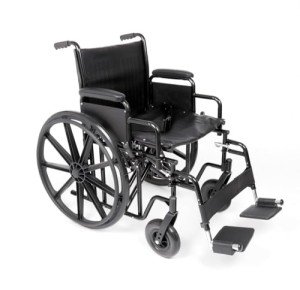Bariatric Wheelchair Seat Width
Seat Width
Having the correct seat width is crucial to wheelchair users who spend longer periods in their chairs. Too narrow a seat will cause pressure on the hips and thighs which might cause sores or pressure points. Having too broad a seat can likewise make it tough for the user to reach the hand rims to move themselves or maneuver in small areas.
To measure the right seat width an individual would rest on a chair generally and have their measurement taken across their lap at the best point which is usually their hips. A wheelchair measuring tape can be used to measure this, however a backyard stick is chosen as it prevents individuals from wrapping the tape around their hips which would give an unreliable outcome.
The basic wheelchair seat width is 16" (narrow adult), 18" (standard adult), and 20" (broad adult). For bariatric clients, a 24" seat is offered. This heavy-duty extra wide bariatric wheelchair from Medline features swing-away footrests, a carbon steel frame with rust- and chip-resistant chrome plating, and easy-to-clean vinyl upholstery. It has a weight capacity of 500 pounds.
Seat Depth
Generally, the seat depth of a bariatric wheelchair was included 2" to the measurement taken at the user's best point (typically their hips). This was implied to accommodate additional layers of clothes that might be used during cold weather condition. Nevertheless, this practice is becoming less typical as wheelchair users have the ability to invest more time inside and are not using long coats. This makes the seat depth of a chair lesser when picking a bariatric wheelchair. Nevertheless, it is still important to choose an alternative that offers sufficient assistance for larger users.
The Medline folding extra broad bariatric manual wheelchair includes a comfortable 24" seat width and a durable slide tube silver vein frame. It also has an adjustable axle and tool-free raising legrests.
Seat Height
When it comes to figuring out the correct wheelchair seat width you ought to always determine from the user's widest point which is typically their hips. You will likewise require to consider whether the user is going to be using a winter season coat as this might include 2" to the width needed.

When a wheelchair remains in use it must only be run on level surfaces with the wheel locks fully engaged. This is to avoid the chair from being able to move inclines that are 10 degrees or greater. It is also important to keep in mind that any activity that might move the center of mass in the chair ought to be finished with care. This consists of grabbing items that need the individual to lean out of their seat or attempting to stand up from it.
Whenever you have the chair in use it is advised that you routinely examine it for damage and lubricate any locations that are deemed required. For example, the casters need to be oiled by eliminating the caster fork and using a multi-purpose grease to use to the caster stem bearings. Also, the foot plates can be changed by loosening up the bolt and then moving them to the preferred position. This permits the feet to sit comfortably on the footplate and prevents any pressure points from forming. This can be really unpleasant for the user and if left ignored, can cause press sores.
Weight Capacity
Bariatric wheelchairs are developed to support more weight than standard wheelchairs. This makes them tougher and better geared up to manage falls. They are also usually bigger and wider, making them less maneuverable in tight areas than basic wheelchairs. bariatric living aids require lorries with unique ramps and lifts to fill them, along with chauffeurs who understand how to best transport them from one place to the next.
When choosing a wheelchair, consider its weight capacity as it will be the main determining consider whether it will accommodate your passenger's needs. The weight capacity of the chair is typically listed as a static load, meaning that it indicates the quantity of weight the chair can comfortably hold while standing still. Nevertheless, some manufacturers also note an active load that is based on a drop test and can simulate the effect of somebody sitting down in the chair. This may be a more trustworthy measurement of the weight limit, depending upon your requirements.
If you prepare to carry out activities that shift your center of gravity in the seat (such as reaching for items), make sure to have front casters pointed in a forward direction and wheel locks engaged so the chair will not tip over. Likewise, inspect that casters are lubricated regularly to prevent excessive wear and abrasions. The lubrication procedure involves getting rid of the fork, separating the caster from the wheel, and greasing the caster stem bearings with premium multi-purpose grease.
